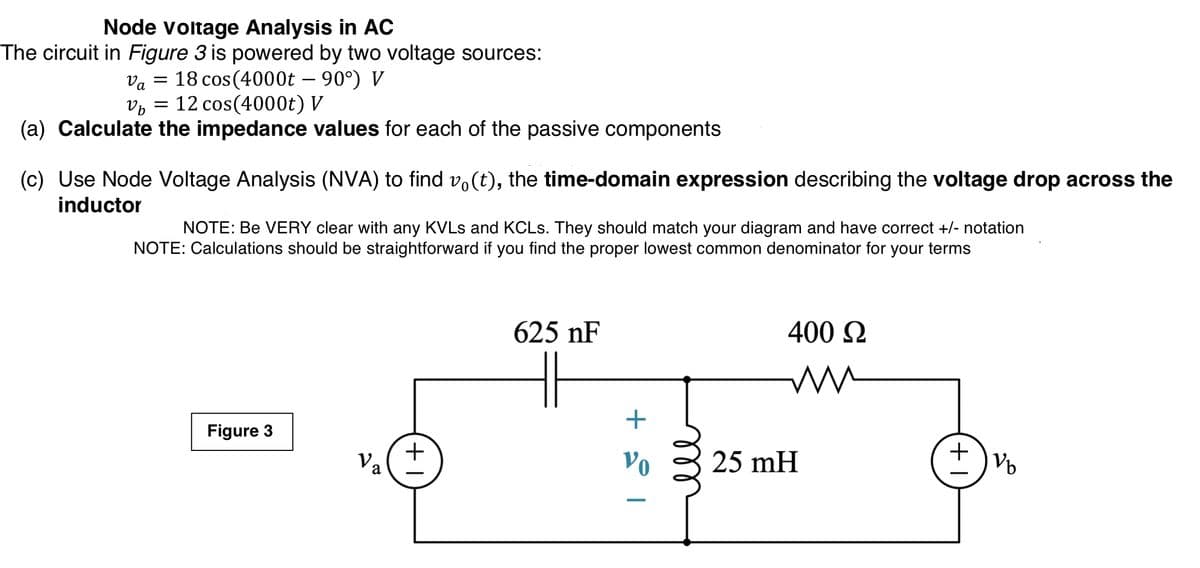Node voltage Analysis in AC The circuit in Figure 3 is powered by two voltage sources: Va = 18 cos(4000t - 90°) V v = 12 cos(4000t) V (a) Calculate the impedance values for each of the passive components (c) Use Node Voltage Analysis (NVA) to find vo(t), the time-domain expression describing the voltage drop across the inductor NOTE: Be VERY clear with any KVLS and KCLS. They should match your diagram and have correct +/- notation NOTE: Calculations should be straightforward if you find the proper lowest common denominator for your terms 625 nF 400 2 + Figure 3 Va Vo 25 mH
Node voltage Analysis in AC The circuit in Figure 3 is powered by two voltage sources: Va = 18 cos(4000t - 90°) V v = 12 cos(4000t) V (a) Calculate the impedance values for each of the passive components (c) Use Node Voltage Analysis (NVA) to find vo(t), the time-domain expression describing the voltage drop across the inductor NOTE: Be VERY clear with any KVLS and KCLS. They should match your diagram and have correct +/- notation NOTE: Calculations should be straightforward if you find the proper lowest common denominator for your terms 625 nF 400 2 + Figure 3 Va Vo 25 mH
Introductory Circuit Analysis (13th Edition)
13th Edition
ISBN:9780133923605
Author:Robert L. Boylestad
Publisher:Robert L. Boylestad
Chapter1: Introduction
Section: Chapter Questions
Problem 1P: Visit your local library (at school or home) and describe the extent to which it provides literature...
Related questions
Question
Need help with a and c

Transcribed Image Text:Node voltage Analysis in AC
The circuit in Figure 3 is powered by two voltage sources:
18 cos (4000t – 90°) V
Va
12 cos(4000t) V
(a) Calculate the impedance values for each of the passive components
(c) Use Node Voltage Analysis (NVA) to find vo(t), the time-domain expression describing the voltage drop across the
inductor
NOTE: Be VERY clear with any KVLS and KCLS. They should match your diagram and have correct +/- notation
NOTE: Calculations should be straightforward if you find the proper lowest common denominator for your terms
625 nF
400 N
+
Figure 3
Va
Vo
25 mH
+,
ell
Expert Solution
This question has been solved!
Explore an expertly crafted, step-by-step solution for a thorough understanding of key concepts.
Step by step
Solved in 3 steps with 3 images

Knowledge Booster
Learn more about
Need a deep-dive on the concept behind this application? Look no further. Learn more about this topic, electrical-engineering and related others by exploring similar questions and additional content below.Recommended textbooks for you

Introductory Circuit Analysis (13th Edition)
Electrical Engineering
ISBN:
9780133923605
Author:
Robert L. Boylestad
Publisher:
PEARSON

Delmar's Standard Textbook Of Electricity
Electrical Engineering
ISBN:
9781337900348
Author:
Stephen L. Herman
Publisher:
Cengage Learning

Programmable Logic Controllers
Electrical Engineering
ISBN:
9780073373843
Author:
Frank D. Petruzella
Publisher:
McGraw-Hill Education

Introductory Circuit Analysis (13th Edition)
Electrical Engineering
ISBN:
9780133923605
Author:
Robert L. Boylestad
Publisher:
PEARSON

Delmar's Standard Textbook Of Electricity
Electrical Engineering
ISBN:
9781337900348
Author:
Stephen L. Herman
Publisher:
Cengage Learning

Programmable Logic Controllers
Electrical Engineering
ISBN:
9780073373843
Author:
Frank D. Petruzella
Publisher:
McGraw-Hill Education

Fundamentals of Electric Circuits
Electrical Engineering
ISBN:
9780078028229
Author:
Charles K Alexander, Matthew Sadiku
Publisher:
McGraw-Hill Education

Electric Circuits. (11th Edition)
Electrical Engineering
ISBN:
9780134746968
Author:
James W. Nilsson, Susan Riedel
Publisher:
PEARSON

Engineering Electromagnetics
Electrical Engineering
ISBN:
9780078028151
Author:
Hayt, William H. (william Hart), Jr, BUCK, John A.
Publisher:
Mcgraw-hill Education,